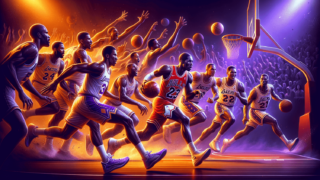
Emergence of Two-Way Players in Basketball
Written by: Basketball Universe
Last updated:

As the clock ticks loudly and the courtside fans hold their breath, the exciting world of basketball has been witnessing a thrilling evolution in recent years – the rise of two-way players. Often seen as the Swiss army knives of the hardwood, these game-changing athletes are dominating both ends of the court, leaving spectators awe-struck and opponents shaking in their sneakers. Whether it’s sniping three-pointers or shutting down the rival team’s star player, two-way players have solidified their position as the ultimate on-court strategists. In this adrenaline-pumping blog post, we’ll crawl under the skin of these unique athletes, dissecting their meteoric rise, and unravel the secrets behind their incredible versatility on the court. So lace up your sneakers, grab your favorite game-time snack, and join us as we delve into the exhilarating world of two-way players in basketball.
Emergence of Two-Way Players in Basketball
The emergence of two-way players in basketball can be attributed to the increasing pace and complexity of the modern game. As offensive schemes and defensive strategies have developed, teams have started to recognize the value of having players with the versatility to excel on both ends of the court. Two-way players are positioned to make an impact on offense and defense, often possessing elite scoring abilities, rebounding skills, and defensive prowess. This versatility allows them to adapt to various lineups and situations, providing their teams with a valuable edge in high-stakes matchups. Coaches and front offices alike have come to appreciate the importance of two-way players, resulting in a shift in player development and an emphasis on this multi-faceted skill set.
Shifting Tides in Basketball Rosters
Not too long ago, basketball rosters were filled with specialists who excelled in specific areas of the game. However, with teams adapting to innovative schemes and strategies, the demand for two-way players, those versatile enough to contribute in multiple ways, has surged. The changing landscape of the game has altered how franchises build their rosters, shifting the focus from pure scorers or defenders to individuals with a more complete skill set.
Two-Way Superstars: Bridging the Gap between Offense and Defense
The basketball world has witnessed numerous elite two-way players throughout its history. Earning their status as some of the greatest ever to play the game, these individuals’ abilities to excel on both offense and defense set them apart. Michael Jordan, considered the epitome of a two-way player, terrorized opposing teams with his scoring prowess while also being a defensive nightmare. Today’s NBA is no different, with superstars like LeBron James, Kawhi Leonard, and Giannis Antetokounmpo leading the charge, proving that success on both ends of the court is not only possible but essential to building a winning team.
The Role of Rule Changes in Basketball’s Evolution
Three-Point Revolution
One of the most significant rule changes in basketball history was the introduction of the three-point line in 1979, which has revolutionized the game as we know it. Teams have increasingly concentrated their efforts on generating more three-point attempts, fundamentally altering offensive strategies. With points now coming in bunches from beyond the arc, two-way players capable of knocking down triples while locking down opponents are a hot commodity. The skillsets of players like Klay Thompson and Jimmy Butler, who can drain the long ball and defend at a high level, fit this mold perfectly.
Hand-Checking Rules
Another significant rule change in the NBA, aimed at increasing scoring, was the strict enforcement of hand-checking in the early 2000s. This rule forbids defenders from using their hands to impede an offensive player’s progress, forcing defenders to move their feet and rely on quickness and athleticism rather than size and strength. This alteration in defensive strategies has brought forth an emphasis on versatile players who excel in help defense and can switch assignments easily. Draymond Green of the Golden State Warriors is an exemplary two-way player in this regard, as he’s known to guard multiple positions and disrupt the opposition’s offensive flow.
Small Ball: Changing the Way the Game is Played
The uptick in pace and the emphasis on the three-point shot have given rise to “small ball” – a style of play employing smaller, more versatile players at every position. Gone are the days of lumbering, back-to-the-basket big men, replaced by agile mobile players capable of stretching the defense with their shooting range. This transition in style has placed an even greater emphasis on the value of two-way players, as teams search for athletes who can compete on both ends of the court while fitting seamlessly into these lineups. Notable examples of such players include Anthony Davis, who brings a rare combination of size, agility, and shooting to the table, making him the ideal weapon in the small-ball era.
The Importance of Analytics in Identifying Two-Way Talent
Advanced Metrics Revolution
The growing reliance on advanced analytics in basketball has helped teams realize the importance of two-way players. Metrics like Player Impact Plus-Minus (PIPM), which assesses a player’s contributions on both ends of the court through a plus-minus value, showcase the best two-way performers in the league. By demonstrating a player’s tangible contributions, these advanced metrics help teams identify potential stars and create strategies around their unique strengths.
Scouting and Drafting
Player scouting and drafting have evolved due to the increasing influence of analytics. Colleges and professional basketball circles have identified the value in selecting versatile athletes with high two-way potential. Prospects like Cade Cunningham, who has shown a natural ability to excel offensively and defensively in college, instantly become coveted pieces for NBA franchises looking to build rosters around players with a diverse skill set.
Incorporating Two-Way Players in Development and Training
Coaches and trainers have recognized the importance of nurturing two-way talent on all levels, from the youth leagues to professional basketball. Customized player development regimens are now tailored to help athletes maximize their dual-threat potential, emphasizing ball-handling, shooting, and decision-making, as well as defensive technique and awareness.
Youth Basketball Programs: Building the Foundation
As the landscape of basketball shifts, youth programs have started to develop versatile players with a focus on all aspects of the game. By prioritizing the development of a complete skill set, young athletes are now better equipped to make an impact on both ends of the court as they progress to higher levels of competition.
Professional Development: Refining Two-Way Skills
Teams are investing more in player development, hiring specialized coaches and trainers to nurture and refine their athletes’ offensive and defensive capabilities. This investment is evident with two-way standouts like Jayson Tatum and Bam Adebayo, who have become sensational on both sides of the ball due to their teams’ dedication to improving their game.
How Two-Way Players are Changing the Game
As basketball history unfolds, two-way players have shifted the way teams approach roster construction and tactics. Coaches now emphasize the importance of having multifaceted threats on the court who force opposing teams to adjust on the fly. With the growing appreciation for two-way talent, we can expect these versatile players to continue shaping the game for years to come.
The Impact on Team Defense
Having two-way players on a team not only elevates individual performances but also enhances overall team defense. A lineup featuring versatile athletes capable of seamlessly switching roles helps teams execute a dynamic, adaptive defensive strategy that stifles opponents. Teams like the 2000s-era Detroit Pistons, the 2015 Golden State Warriors, and the 2020-21 Los Angeles Lakers have experienced success by narrowing their focus on versatile two-way players, which has a ripple effect on the performance of the whole squad.
Matchup Nightmares for Opponents
Two-way players present significant matchup problems for opposing teams, especially during high-pressure situations and the playoffs. Players like Kawhi Leonard and Paul George are known for their ability to exploit matchups at both ends, forcing coaches to make difficult adjustments. This versatility proves invaluable when the game is on the line, and securing a win relies on exploiting mismatches and creating scoring opportunities.
Building a Culture of Versatility
Emphasizing two-way players not only improves on-court performance but also fosters a culture of hard work and versatility within the team. When franchises build their rosters around athletes who excel in all facets of the game, it sends a message to the entire team about the importance of continuous improvement and dedication. This culture of striving for excellence in every area of the game eventually becomes contagious, inspiring and motivating all players to elevate their skill set.
The Best of the Best: Examples of Today’s Elite Two-Way Players
As the role of two-way players continues to gain importance, we can take a closer look at some of today’s leading versatile athletes to see the impact they have on their respective teams:
- LeBron James: A perfect example of an elite two-way player, LeBron has led his teams to four NBA championships through his all-around skills. An undeniable offensive threat with a court vision rarely matched, he is also an impressive defender with his athleticism, strength, and awareness.
- Kawhi Leonard: Dubbed as “The Klaw” for his enormous hands and relentless defense, Leonard has emerged as a premier two-way player in the league. His incredible wingspan and defensive IQ allow him to shut down the opposition’s best scorer, while his finely tuned offensive game featuring improved shooting and playmaking helps lead his team to victory.
- Giannis Antetokounmpo: The “Greek Freak” has showcased an incredible skillset as a two-time MVP, excelling offensively with his exceptional size, speed, and strength. Not one to rest on his laurels, Giannis has also developed into a fearsome rim protector and on-ball defender, elevating his status as a premier two-way player.
With the game of basketball evolving and the value of two-way players higher than ever before, it is clear that versatility will remain key to success in the coming years.
FAQ Section: Two-Way Players in Basketball
If you’re looking to learn even more about two-way players in basketball, here are some frequently asked questions (FAQs) and brief answers that cover essential aspects of the topic. Read on to satiate your curiosity about these versatile athletes and their game-changing impact on the sport of basketball.
What defines a two-way player in basketball?
A two-way player is someone who excels at both offensive and defensive aspects of basketball. They typically possess a strong scoring or playmaking ability, combined with a high level of defensive skill, enabling them to impact the game at both ends of the court.
Why have two-way players become more valuable in recent years?
Two-way players have become more valuable due to the increased pace, complexity, and versatility of the modern game. Their ability to contribute on both ends of the court allows them to adapt to different lineups and situations, providing a significant advantage in today’s fast-paced, positionless basketball style.
Are there any significant rule changes that have contributed to the rise of two-way players?
Yes, the introduction of the three-point line and the stricter enforcement of hand-checking rules have contributed to the rise of two-way players. The three-point revolution has changed offensive strategies, while the hand-checking rules have altered defensive strategies, promoting the development of versatile and athletic players who can excel in both aspects.
Which NBA players are currently considered elite two-way players?
Some of the current elite two-way players in the NBA include LeBron James, Kawhi Leonard, Giannis Antetokounmpo, Jimmy Butler, and Paul George. These players showcase exceptional skills on both ends of the court, making them valuable assets to their respective teams.
What impact do two-way players have on team defense?
Two-way players enhance a team’s overall defense by providing flexibility and adaptability. Their ability to switch roles and assignments seamlessly allows teams to implement dynamic, adaptive defensive strategies that disrupt the opposition’s offensive flow.
How do two-way players create matchup problems for opponents?
Two-way players create matchup problems for opponents by exploiting mismatches on both offense and defense. Their versatility enables them to take advantage of favorable situations, forcing opposing coaches to make difficult adjustments throughout the game.
How have analytics impacted the evaluation and development of two-way players?
Advanced analytics have helped teams quantify the contributions of two-way players more accurately. Metrics like Player Impact Plus-Minus (PIPM) enable teams to identify potential stars and tailor strategies around the unique strengths of versatile athletes. This increased focus on analytics has also influenced player scouting, drafting, and development.
What role do youth basketball programs play in nurturing two-way players?
Youth basketball programs are crucial in building the foundation for versatile athletes. By emphasizing the development of a complete skill set, young players become better equipped to make an impact on both ends of the court as they progress through higher levels of competition.
How do teams incorporate two-way players in professional development?
Teams invest in player development by hiring specialized coaches and trainers to nurture and refine their athletes’ offensive and defensive capabilities. This investment helps two-way players, like Jayson Tatum and Bam Adebayo, become exceptional performers on both sides of the ball.
What impact does the emergence of two-way players have on basketball’s future?
The emergence of two-way players will likely continue to shape the sport, influencing team roster construction, tactics, and player development. Their overall impact on the game highlights the importance of versatility, athleticism, and adaptability as essential elements of modern basketball.
Featured Posts
- No pillar pages found.





